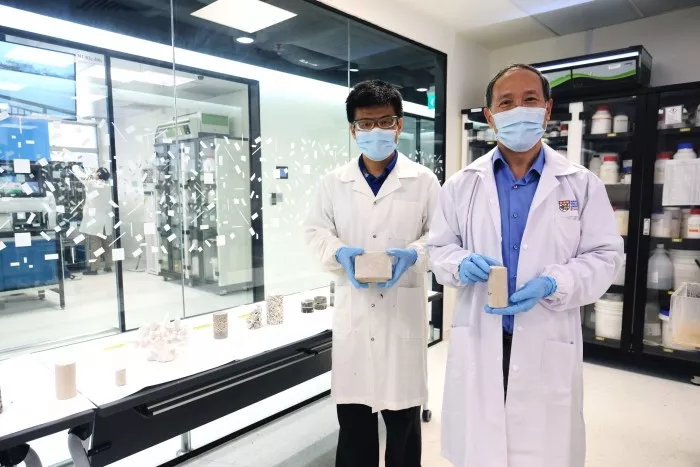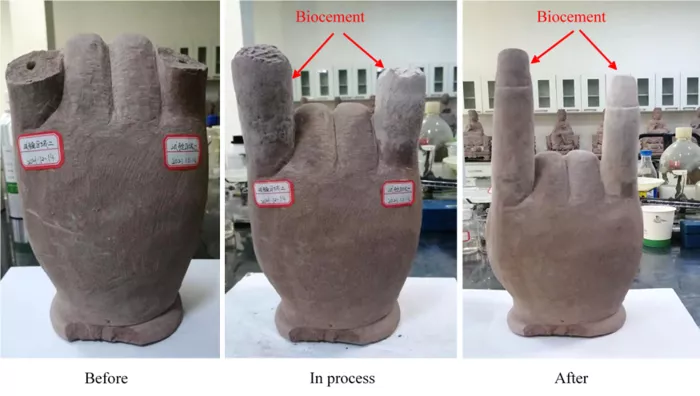Scientists at NTU Singapore have discovered a method to produce biological cement from waste materials, making this method to replace traditional cement greener and more sustainable. Biological cement is a kind of renewable cement, which uses bacteria to produce hardening reaction and combine soil into solid blocks. Scientists have now produced biocement from two common wastes: Industrial carbide sludge and urea (from mammalian urine).
They designed a method to form a hard solid, or sediment, through the interaction between urea and calcium ions in industrial carbonized sludge. When this reaction occurs in the soil, the sediment binds the soil particles together and fills the gaps between them, thus forming a compact soil mass. This produces a kind of biological cement block, which is strong, durable and low permeability.
The research team led by Professor Chu Jian, Dean of the school of civil and environmental engineering of the University, showed in the proof of concept research paper published in the Journal of environmental chemical engineering on February 22, 2022 that the biological cement they invented may become a sustainable and cost-effective soil improvement method, such as strengthening the ground for construction or excavation, controlling beach erosion, and reducing dust or wind erosion in the desert, Or build fresh water reservoirs on the beach or in the desert. It can also be used as biological grouting to seal the cracks of rocks to control leakage, and even modify and repair monuments such as rock carvings and statues.

Dr. wushifan, senior researcher of urban Solutions Center, School of civil and environmental engineering, Nanyang University of technology, and Professor Chu Jian, chairman of School of civil and environmental engineering, Nanyang University of technology, held a biological cement block made of urea and carbonized sludge.
"Biocement is a sustainable and renewable alternative to traditional cement, and has great potential in building projects that need to deal with the ground," said Professor Chu, who is also the director of the urban Solutions Center of Nanyang Technological University. "Our research makes the biological cement more sustainable by using two types of waste as raw materials. In the long run, it can not only reduce the manufacturing cost of biological cement, but also reduce the cost involved in waste treatment."
The research of NTU scientists supports NTU 2025 strategic plan, which aims to solve some major human challenges, including reducing human impact on the environment by promoting research and development of sustainable development.
Urine, bacteria and calcium. Simple formula of biological cement
Compared with traditional cement production methods, the manufacturing process of biological cement requires less energy and produces less carbon emissions.
The biological cement produced by the Nanyang Technological University team is made of two types of waste: Industrial carbonized sludge - waste from the production of acetylene gas in Singapore factories - and urea in urine.
First, the team treated carbide slag with an acid to produce soluble calcium. Urea is then added to soluble calcium to form a cementation solution. The team then added a bacterial culture to the consolidated solution. Bacteria in the culture will decompose urea in the solution to form carbonate ions.
These ions react with soluble calcium ions in a process called microbial induced calcite precipitation (micp). This reaction resulted in calcium carbonate, a hard solid material that occurs naturally in chalk, limestone, and marble.

The test specimens of the Bergamot new material restoration project were provided by the Dazu stone carving, a UNESCO World Cultural Heritage site in China.
The restoration work using biological cement was completed by Dr. Yang Yang at Chongqing University, China. The biological cement solution is colorless, so that the restoration work can maintain the original color of the carving.
When this reaction occurs in soil or sand, the generated calcium carbonate binds the soil or sand particles together to increase their strength and fill the pores between them to reduce the leakage of water through the material. The same process can also be used in rock crevices, so that rock carvings and statues can be repaired.
Soil reinforced with biocement has an unconstrained compressive strength of up to 1.7 megapascals (MPA), which is higher than that of the same soil treated with the same amount of cement.
This makes the team's biocement suitable for soil improvement projects, such as strengthening the ground or reducing water infiltration, building or excavating or controlling beach erosion along the coastline.
The first author of the paper, Dr. Yang Yang, was a doctoral student of Nanjing University and a research assistant of the urban Solutions Center. At present, he is a postdoctoral researcher of Chongqing University.